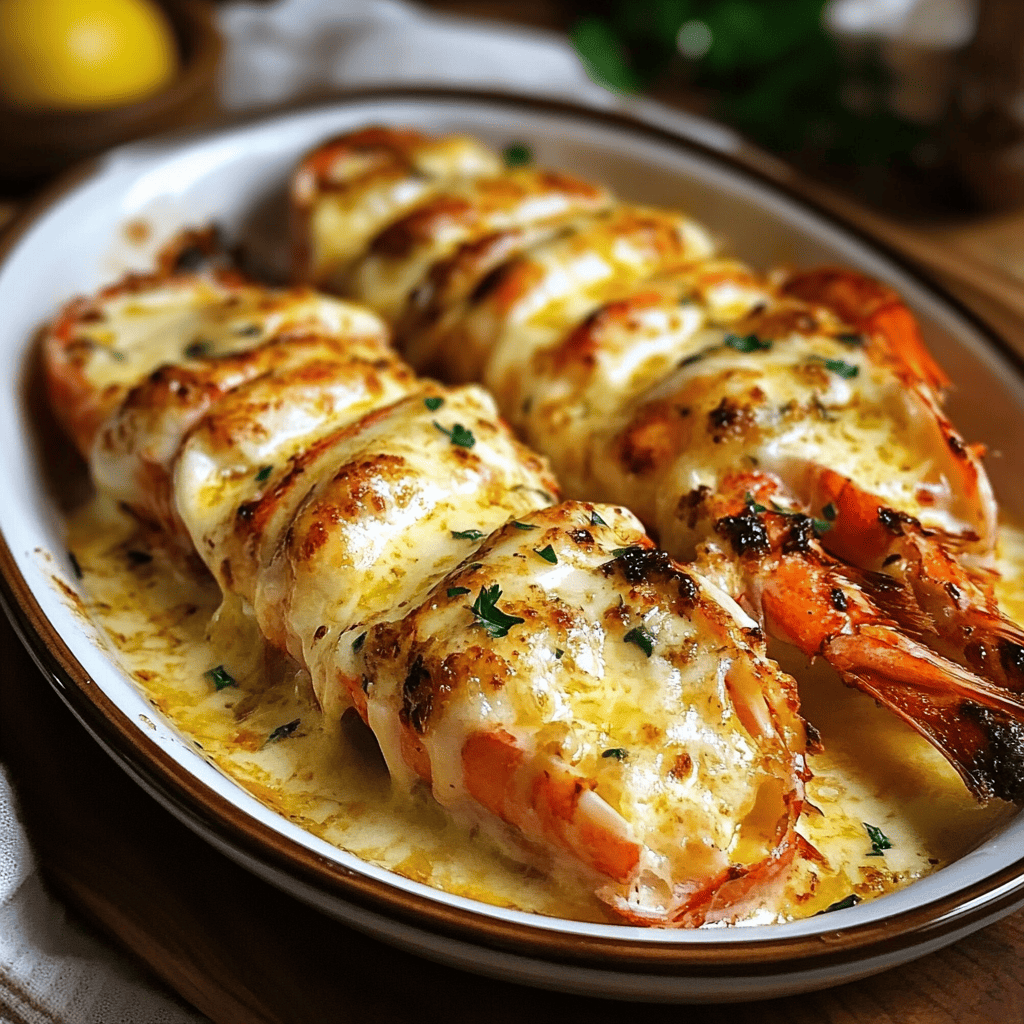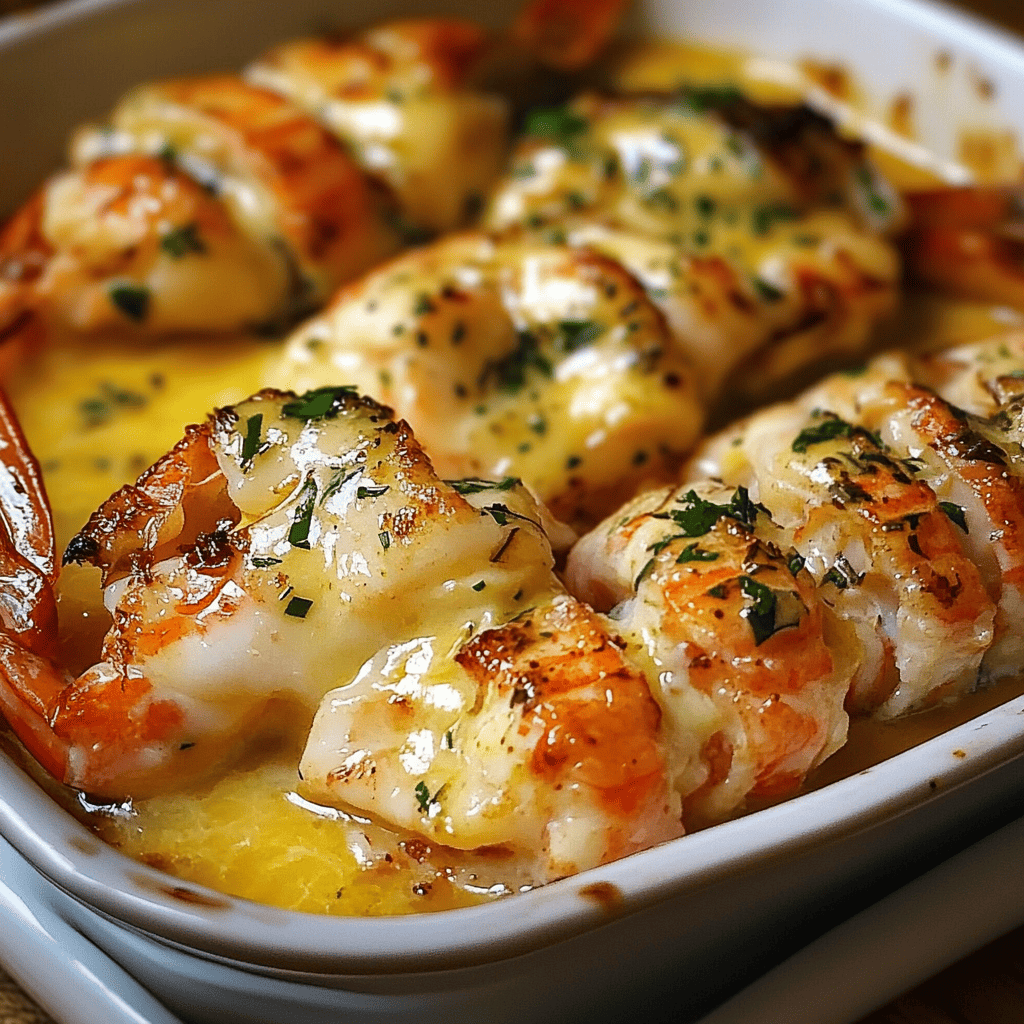Baked Lobster with Garlic Butter
Introduction
Lobster is considered one of the jewels of the sea, a symbol of luxury and sophistication. Baking it in the oven with garlic butter not only highlights its sweet and delicate flavor but also preserves its soft and juicy texture. This preparation, while elegant, is surprisingly simple and perfect for celebrations or special dinners. The aroma of melted butter with garlic and parsley transforms any occasion into a true feast.
For centuries, lobster has been one of the most prized seafood products for its delicate flavor, meaty texture, and imposing presence on the table. Baking it with garlic butter is a technique that enhances its qualities without overpowering them, creating an elegant, aromatic, and memorable dining experience.
This dish not only represents the refinement of seafood cuisine, but also connects us with culinary traditions that value the simplicity of natural ingredients and quality. Ideal for celebrations, romantic dinners, or gourmet menus, baked lobster proves that with just a few ingredients, spectacular results can be achieved.

A brief history of lobster in the kitchen
Originally, lobster wasn’t always considered a delicacy. In the 17th century, on the coast of New England (USA), it was so abundant that it was used to feed prisoners and workers. As time passed and its population declined, its price and prestige increased, making it a luxury product.
Today, preparing it in the oven with flavored butter is one of the most popular and traditional ways to serve it in high-end restaurants.
A detailed history of lobster in gastronomy
Lobster, that majestic crustacean with white meat and a delicate flavor, has traveled a long and curious path from its abundance on the Atlantic coast to becoming one of the most coveted ingredients in haute cuisine. Its history is full of contrasts, social evolution, and culinary transformations.
From food for the poor to a delicacy for kings
In the 17th century and throughout much of the 18th century, lobster was considered a food for the poor. In the British colonies of North America, especially in New England, lobster was so abundant that it washed up on beaches in huge numbers after storms. It was easily harvested and used as fertilizer, fishing bait, or food for slaves, prisoners, and servants.
In fact, there are legal records showing that some workers were required in their contracts to eat lobster no more than two or three times a week, considering it a punishment.
The change of status
It wasn’t until the late 19th century that the landscape began to change. Thanks to the development of rail transport and canning techniques , lobster began to reach inland areas of the United States, where its exotic appearance and unique flavor made it highly prized. Ironically, what was a “cheap food” on the coast became a luxury in the cities.
Gradually, chefs began experimenting with more sophisticated recipes. Thus, the tradition of preparing it steamed, boiled, or baked with special sauces was born, such as the classic melted butter with garlic and parsley , which perfectly complements its natural flavor.
Baked lobster: a contemporary classic
Baked lobster with garlic butter became established in the 20th century as one of the most appreciated methods for its simplicity and elegance. It doesn’t disguise the flavor of the seafood, but rather enhances it , allowing the meat to remain juicy, tender, and aromatic.
It is especially popular in coastal cuisines of North America, Mediterranean Europe, and Caribbean countries , where it is served on special occasions, romantic dinners, or holiday celebrations.
An international delicacy
Today, lobster is a symbol of gastronomic luxury around the world. In high-end restaurants, its high price reflects not only its quality, but also the difficulty of its sustainable harvesting and delicate handling. Even so, lobster remains a dish that impresses with its flavor and presentation , without the need for complicated techniques.
Summary of its evolution
| Time | Social consideration | Common preparation method |
|---|---|---|
| 17th-18th centuries | Low-status food | Boiled, used as fertilizer or bait |
| 19th century | Appreciated by upper classes | Canned, cooked, exported |
| 20th century onwards | Luxury delicacy | Baked, grilled, with butter or gourmet sauces |

Ingredients (for 2 people)
- 2 fresh lobster tails
- 3 tablespoons unsalted butter
- 2 cloves of garlic, finely chopped
- 1 tablespoon lemon juice
- 1 tablespoon chopped fresh parsley
- Salt and pepper to taste
- Pinch of sweet paprika (optional)
Step-by-step preparation
- Prepare the lobsters:
Using kitchen shears, cut the tops of the lobster tails lengthwise. Gently separate the meat from the shell, without removing it completely, and place it on top of the shell for easier baking. - Prepare the aromatic butter:
Melt the butter in a pan over low heat, add the chopped garlic, and cook for a few seconds without letting it brown. Add the lemon juice, salt, pepper, paprika (optional), and parsley. Mix well. - Bake:
Place the lobster tails on a baking sheet. Brush the meat generously with butter. Bake at 200°C (392°F) for 12-15 minutes, depending on the size. - Grilling (optional):
If you want a golden finish, put them under the grill (broil) for 1-2 minutes at the end. - Serve:
Drizzle with more hot butter and sprinkle with fresh parsley. Serve with rice, salad, or roasted potatoes.
Frequently Asked Questions
- Can you use frozen lobster?
Yes, but it must be completely thawed in the refrigerator before cooking. - How do I know if lobster is cooked?
Its meat turns opaque, white, and firm to the touch. - What wine does it pair well with?
White wines like Chardonnay, Sauvignon Blanc, or even dry sparkling wines. - Frequently asked questions and other useful information
- 1. Is it difficult to cook lobster in the oven?
- No, it’s a simpler recipe than it seems. The key is not to overcook it, as its meat is delicate and requires careful attention.
- 2. How to choose a good lobster?
- If fresh, it should be jiggly if live or have a clean, marine aroma if raw. The tails should be firm, without dark spots.
- 3. What accompaniments are ideal?
- Baked potatoes, herbed rice, steamed vegetables, or a citrus salad. Rustic bread for dipping in butter is also excellent.
- 4. What wine goes with this dish?
- Chardonnay, Albariño, Sauvignon Blanc, or a dry sparkling wine. It also pairs well with dry rosé.
- 5. Is it possible to prepare the lobster in advance?
- You can clean and open the lobster beforehand, but it’s best to bake it just before serving to maintain its ideal texture.
- Fun fact:
- In the past, lobster was considered food for slaves and prisoners, and it wasn’t until the 19th century that it became a luxury product.
- Texture and Flavor Context of Consumption Visual Appearance Curiosities Estimated Nutritional Value (per portion of 1 medium lobster with butter – approx. 250 g of meat + 2 tbsp of butter) Other Interesting Information
Texture:
Lobster meat is firm but tender , slightly fibrous but juicy when cooked thoroughly.
When baked, it acquires a meaty texture , balanced by the melting softness of the garlic butter .
When lightly grilled, it can have a golden, crispy crust on top .
Flavor:
Delicate and marine, with a slightly sweet and salty flavor typical of fresh seafood.
Garlic butter provides an intense, aromatic, and savory touch , with earthy notes and a slight spiciness. Fresh herbs
such as parsley, chives, or dill can be added to enhance its freshness. Typical dish for special occasions , elegant dinners, romantic celebrations, Christmas, or New Year’s. Very common in high-end coastal restaurants , but it can also be prepared at home for a gourmet evening . It is served as a main course , accompanied by roasted potatoes, rice, salad, or artisan bread. Striking presentation: the open lobster with its white meat exposed, glistening with melted butter and decorated with fine herbs. The intense red shell contrasts with the shiny gold of the butter and the creamy white of the meat. It is usually served in the same shell, which highlights its marine origins and its festive character . In the past, lobster was considered food for the poor or prisoners in the American colonies , until it became a luxury delicacy. Garlic butter has historically been used to enhance seafood without overshadowing its natural flavor . An average lobster (500 g – 1 kg) contains a good amount of meat, mainly in the tail and claws. Preparing it in the oven prevents it from overcooking, as can happen when boiling it. Calories: 300 – 450 kcal Fat: 20 – 30 g Protein: 28 – 35 g Carbohydrates: 0 – 2 g Cholesterol: High (due to being seafood and the butter)
Sodium: Moderate to high (natural in seafood)
Vitamins and minerals: rich in B12, zinc, phosphorus, and selenium It can also be prepared with lemon or a touch of dried chili for a more gourmet profile. To open the lobster and extract the meat easily, it is useful to use special tongs or kitchen scissors . There are lighter versions using olive oil, garlic, and lemon , without butter.

Conclusion
Baked lobster with garlic butter represents the best of the sea in a single bite. Its preparation highlights the natural flavor of the seafood without overpowering it, combining simple technique with spectacular results. This elegant and seductive dish has the power to transform an ordinary dinner into an unforgettable gastronomic experience.
In addition to being a showcase of culinary refinement, it’s also a way to explore the art of seafood cooking, respecting its original flavors and honoring one of the ocean’s most prized ingredients.
Baked Lobster with Garlic Butter is much more than an elegant recipe; it’s the union of simplicity and sophistication, of the sea and home cooking. It reminds us that great dishes don’t require complications, just quality ingredients, a little technique, and a passion for cooking.
This dish represents how gastronomy can transform a humble ingredient from the past into a modern culinary icon. Its preparation pays homage to the authentic flavor of the sea, enhanced with warm notes of garlic, fresh herbs, and melted butter.
Whether for a special occasion or as an expression of love for seafood cuisine, this recipe is a choice that impresses, satisfies and lingers in the palate’s memory .

